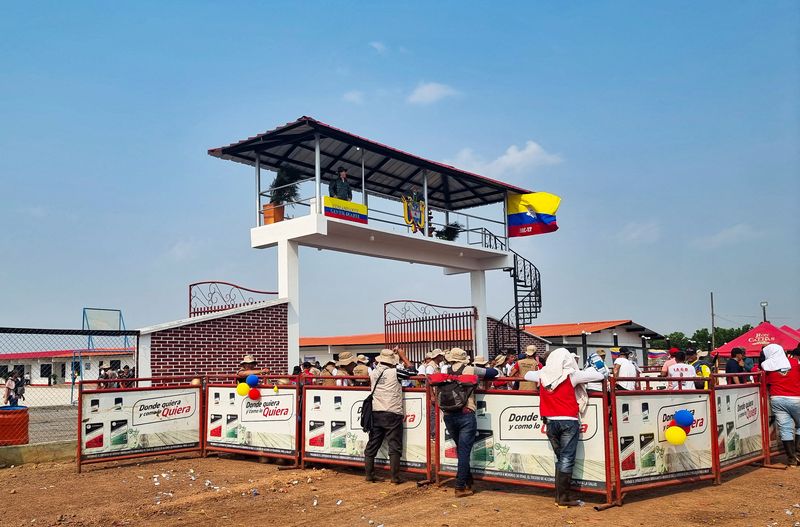Guerrilla pseudo-state complicates the search for peace in Colombia
2024.05.02 08:06

By Luis Jaime Acosta
YARI PLAINS, Colombia (Reuters) – A group of children holding red, yellow and blue balloons – the colors of Colombia’s flag – run to the playground of a newly-opened school built and paid for by the Estado Mayor Central (EMC (NYSE:)) guerrillas.
The new school – which opened last month in a troubled area in the country’s south – is just one example of how the group is consolidating control of certain regions, gaining social support and territorial dominance, and potentially stymieing already-fraught efforts by President Gustavo Petro to ink a new peace deal.
The 3,500-strong EMC are rebels who rejected a landmark 2016 peace deal with the government that largely put an end to decades of conflict. Dissidents from the Revolutionary Armed Forces of Colombia (FARC), they remain armed and committed, they say, to Marxist ideals like wealth and land redistribution.
The EMC’s construction of a pseudo-state – building clinics, roads and bridges – is a strategy to bring it closer to local people in places with minimal state presence, government officials, security sources and analysts say, giving the rebels a stronger position at the negotiating table.
Control of territory also allows the EMC to expand drug trafficking and illegal mining, funding its armed operations, the security sources said, hurting U.S. and Colombian anti-drug efforts and damaging fragile Amazon (NASDAQ:) ecosystems.
As in other countries where guerrillas or criminal groups have filled a void of state presence, their efforts have sowed distrust of security forces, said a high-ranking army official who asked to remain anonymous.
3rd party Ad. Not an offer or recommendation by Investing.com. See disclosure here or
remove ads
.
But the EMC says they are bringing benefits to marginalized communities.
“It’s a dream … for the communities,” EMC second-in-command Alexander Diaz Mendoza, better known by his nom de guerre Calarca Cordoba, told Reuters at the school opening. “Especially for this region which has been excluded by the state.”
The EMC, which entered peace talks with the Petro government last year, inherited the pseudo-state building practice from its predecessor the FARC, which demobilized under the 2016 peace deal. It is now Colombia’s third-largest armed group.
Around 13,000 people demobilized under the FARC deal, which mandated the group’s leaders face war crimes investigations, but other armed groups – including crime gangs, dissidents like the EMC and the National Liberation Army (ELN) rebels – remain active, counting some 17,600 members between them.
Petro has promised to end the 60-year conflict, which has killed 450,000 people, through new peace deals, but he is confronting significant hurdles, including the partial suspension of a ceasefire with the EMC.
“The school is for the communities, for the children, who need it,” Calarca said before inaugurating the building, whose 12 classrooms, computer room, dormitories and other facilities outclass many rural schools in Colombia.
Camilo Gonzalez, the government’s head negotiator at the talks with the EMC, said such initiatives happened because the state was not present.
“If infrastructure is being constructed illegally it’s because legally it doesn’t happen,” he said.
Petro’s government has pledged to fight inequality with improvements to public services and healthcare in far-flung regions, but the president’s reforms have struggled in congress and many programs have yet to come to fruition.
3rd party Ad. Not an offer or recommendation by Investing.com. See disclosure here or
remove ads
.
Gonzalez said the guerrillas’ “substitution of the state” would be discussed at the peace talks, and that it made the talks harder.
Constructions like the school are a form of social control, said Crisis Group analyst Elizabeth Dickinson.
“The closer an armed group is to the population, the harder it is to move toward peace, because they are ever more a part of society,” said Dickinson, adding that her group’s investigations have shown that the EMC also imposes its own justice system in some regions.
It is more beneficial for the EMC to build infrastructure than it is for them to confront the state militarily, Dickinson said.
ILLEGAL FINANCING?
The construction of the school in the Yari plains, deep in Caqueta province in the Amazon Basin, cost some 3.2 billion pesos, about $800,000, said rebel leader Calarca.
Calarca said his group also spent some $900,000 on an agriculture and reforestation project, though he would not provide details of the funds’ origin.
The armed forces accuse the EMC and other armed groups of drug trafficking, illegal mining, kidnapping and extortion.
As part of the 2016 deal, the FARC admitted their involvement in drug trafficking.
Groups like the EMC “oblige us to rethink our strategy,” General William Salamanca, director of the national police, told Reuters, adding that where there was armed group presence the state needed to invest in local communities.
“The transition from war to peace includes public works beyond fighting criminal organizations,” said the army official, adding that territorial control facilitates money laundering.
3rd party Ad. Not an offer or recommendation by Investing.com. See disclosure here or
remove ads
.
For residents, the pseudo-state brings clear advantages.
“This is an opportunity for young people, for the children,” said farmer and Yari community leader Raul Avila, who said the state has traditionally been present in the area only through the military. “We have never seen community investment, we’ve always been abandoned.”
“We’ve made a state within a state,” said Avila, as 1,000 people gathered to celebrate the school opening.
The EMC is ready if the government tries to delay the school from functioning, rebel leader Calarca said.
“If they don’t put it into operation, we will.”








